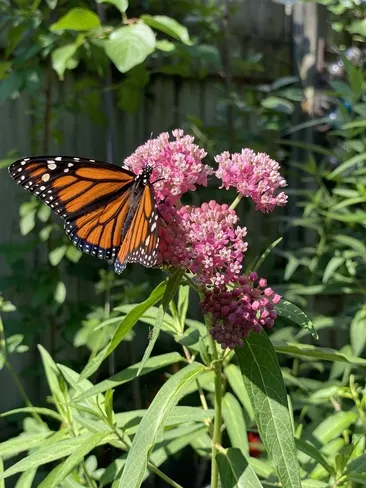
The beloved orange and black monarch added to IUCN red list
The existence of the migratory monarch butterfly has become as fragile as the wings that take them on their 8,000 kilometre annual journey. The International Union for Conservation of Nature (IUCN) has added the butterfly to their endangered Red List.
The bright orange wings of the migratory monarch are a hallmark of Canadian summers. However, the populations have been declining. Between 1996 and 2021 the eastern population of the butterfly declined by 84%. The western population has had the most devastating decline. That population has had an estimated 99.9% decline from as many as 10 million butterflies to just 1,914 between the 1980s and 2021.
SEE ALSO: Glimmer of hope in 2021 for these vulnerable species in Canada
Logging, both legal and illegal along with deforestation for agriculture and urban development, has already destroyed substantial areas of the butterflies’ winter shelter in Mexico and California. But it’s not only their habitats being destroyed that’s impacting populations.
The use of herbicides and pesticides in agriculture kill both the milkweed plant and butterflies. Milkweed is crucial to the monarch's life cycle. The tall colourful plant is where the monarch lays her eggs. The hatched larvae will stay on the milkweed and feed until it reaches the pupa stage, about 10 days after it has hatched.
Both milkweed and the monarch butterfly are widely impacted by the effects of climate change. Severe weather makes it difficult for the butterflies to survive. Extreme temperatures trigger earlier migration before the milkweed has had opportunity to grow. Wildfires destroy habitats, milkweed, and the insect.
In a press release Anna Walker, member of the IUCN SSC Butterfly and Moth Specialist Group, expressed her disappointment with the declining monarch population but “It is difficult to watch monarch butterflies and their extraordinary migration teeter on the edge of collapse, but there are signs of hope. So many people and organisations have come together to try and protect this butterfly and its habitats. From planting native milkweed and reducing pesticide use to supporting the protection of overwintering sites and contributing to community science, we all have a role to play in making sure this iconic insect makes a full recovery,”
RELATED: Get ready: The monarchs are coming
Dr. Bruno Oberle, IUCN Director General had a more broad and actionable directive. “To preserve the rich diversity of nature we need effective, fairly governed protected and conserved areas, alongside decisive action to tackle climate change and restore ecosystems. In turn, conserving biodiversity supports communities by providing essential services such as food, water and sustainable jobs.”
The migratory monarch butterfly joins 147,517 species on IUCN’s Red List. For now the butterfly has an endangered designation. If the population were to continue to decline they would be classified as critically endangered next. Options after are extinct in the wild, with designations ending with extinction.
VIDEO: A Nova Scotia resort is welcoming new kinds of guests - monarch butterflies
Thumbnail photo by Amanda of Windsor ON, July 14 2022